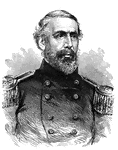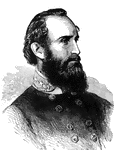Search for "Chancellorsville"

Jackson's Men Rush into the Federal Camp
Thomas J. (Stonewall) Jackson's men rush into the Federal camp at Chancellorsville

Ulric Dahlgren
"Colonel Ulric Dahlgren, born in Bucks County, Pa., in 1842, died near King and Queen's Courthouse,…

General Alfred Pleasonton
"General Pleasonton, born in Washington, D. C., June 7th, 1824, was graduated at the United States Military…

General Hiram G. Berry
"General Berry, born in Thomaston (now Rockland), Me., August 27th, 1824, died at Chancellorsville,…

General Gouverneur K. Warren
"General Warren, born in Cold Spring, N. Y., January 8th, 1830, died in Newport, R. I., August 8th,…

Battle of Chancellorsville
"Battle of Chancellorsville, Va., Friday, May 1st, 1863. We give a fine sketch of the point where the…

Battle of Chancellorsville
"Battle of Chancellorsville, Va. Attack on General Sedgwick's Corps. on Monday, May 4th, 1863, at 5…

Falmouth
"Federal troops marching back into Falmouth after the Battle of Chancellorsville."— Frank Leslie,…

General J. H. Hobart Ward
"General Ward, born in New York city, June 17th, 1823, was educated at Trinity Collegiate School; enlisted…

Battle of Chancellorsville
"Battle of Chancellorsville, Sunday, May 3rd, 1863. General Hooker repulsing the attack of the enemy.…

Battle of Spottsylvania
"The war in Virginia. Battle of Spottsylvania Courthouse- opening of the fight at Alsop's Farm, May…

General Thomas J. Jackson
"General Stonewall Jackson, born in Clarkesburg, W. Va., January 21st, 1824, died at Chancellorsville,…

General Richard S. Ewell
"General Ewell, born in Georgetown, D. C., February 8th, 1817, died in Springfield, Tenn., January 25th,…

Confederate Prisoners
"Confederate Prisoners brought in after the Battle of Chancellorsville."— Frank Leslie, 1896

Battle of Chancellorsville
"Battle of Chancellorsville, Sunday, May 3rd, 1863. General Hooker repulsing the attack of the enemy.…

Battle of Chancellorsville
"Battle of Chancellorsville, Sunday, May 3rd, 1863. General Hooker repulsing the attack of the enemy.…

Battle of Chancellorsville
"Battle of Chancellorsville, Sunday, May 3rd, 1863. General Hooker repulsing the attack of the enemy.…

Ruins of Chancellorsville
The Battle of Chancellorsville was a major battle of the American Civil War, fought near the village…

General Thomas Jonathan "Stonewall" Jackson
Thomas Jonathan "Stonewall" Jackson (1824 - 1863) was on of the most well-known Confederate generals…

March to Chancellorsville
Soldiers marching to Chancellorsville Virginia. The Battle of Chancellorsville was a seven day battle…